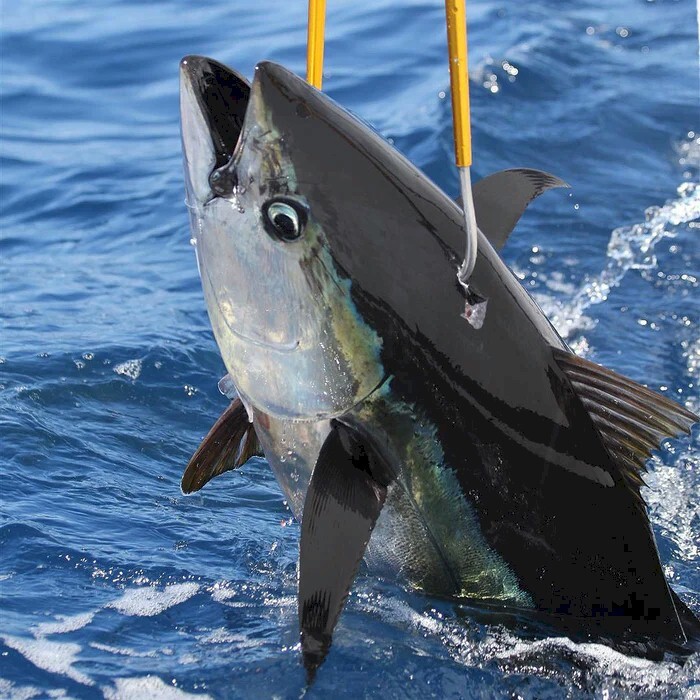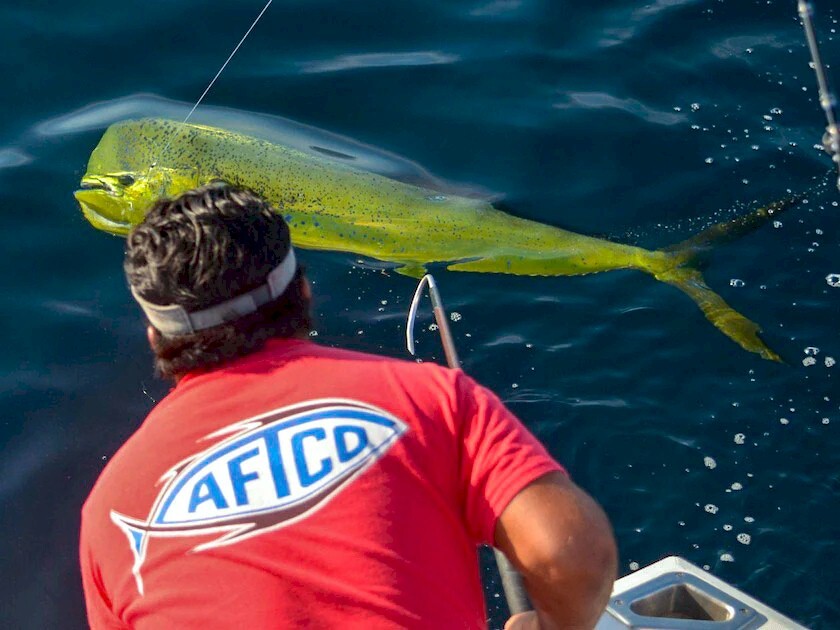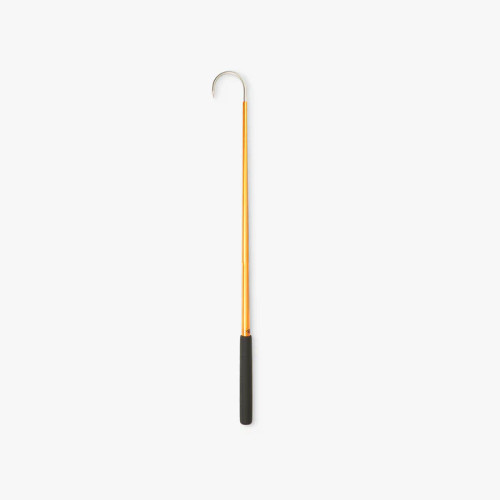Product Description
AFTCO's Taper-Tip Aluminum Gaffs are slim, with a tapered shape makes them bolt fast when slashing through the water and easier to maneuver, making these gaffs sorely accurate. Bring the fish to the boat with less flailing and confusion. Shafts are made from corrosion-resistant marine aluminum and are swaged for uniform strength from top to bottom. Available in our traditional rich gold and popular lustrous black finishes—that are anodized for lasting beauty and resistance to saltwater corrosion. All models are fitted with soft but rugged black grips molded from the same non-slip material found on the finest fishing rods. Vinyl butt caps seal out corrosive moisture and prevent deck scarring.
Features
- Corrosion Resistant Marine Aluminum
- Swaged for uniform strength
- Anodized for resistance to saltwater corrosion
- Black Grips molds with non-slip material
- Black Vinyl Butt caps to seal out corrosive moisture
- Floating Gaffs GFA356 and below

How To Select the Right AFTCO Gaff
AFTCO manufactures 33 different sizes of aluminum and fiberglass fixed-head and flying gaffs. How do you determine the handle length, hook size and best material for your application?
Gaff Length
Gaff length is normally determined by the size and gunnel height of the vessel where the gaff will be used. Anglers fishing from small skiffs and kayaks can usually get away with gaffs measuring 2’ to 4’ in length due to their close proximity to the water. Longer gaffs are tougher to store and handle on smaller skiffs and kayaks, and the gaffing of most fish all takes place close at hand.
On medium sized skiffs and boats from 18’ to 30’ AFTCO recommends gaffs from 4’ to 6’ in length. In most cases, a gaff of 6’ is just about ideal for most all applications gaffing smaller tuna, dorado (also known as mahi mahi), halibut, bass, snappers, etc. Some people like to have a 4’ gaff as a back-up or lifting gaff to be used on bigger fish over 50lbs after the initial 6’ gaff has been placed to control the fish and bring alongside the boat. AFTCO’s most popular selling gaff is a 4’ with 3” hook, like the 354 or 354L.
Fishing boats measuring 30’ to 50’ and above should only need gaffs measuring 6’ to 8’ in length. This allows fish to be easily gaffed from the lower stern area and up in the bow where the gunnel is higher off the water. You can always choke up on a longer 8’ gaff if the need arises, but you can’t make a 6’ gaff reach the water if you must gaff from the bow on a larger vessel!
Hook Size
Gaff hook size is usually determined by the size and shape of the fish being most commonly gaffed. In general, fish under 50lbs only need a gaff hook with gap measuring 2” to 3” to be effective, but on some species such as dorado, king mackerel, barracuda and other slim-bodied species, a 2” hook is almost always the best choice. Fish weighing over 50lbs should almost always be gaffed using a 3” or 4” hook. This allows a bigger bite into the body of the fish and will result in less fish tearing off the hook. On some species such as sharks, large tuna and jumbo cobia, 4” or even our biggest 5” GFA586 gaff should be used. This is due to the soft flesh and tremendous power of cobia and tuna. Sharks have tougher flesh but are notorious for twisting and thrashing their way off the gaff at boat-side.
Handle Material
AFTCO makes fixed-head gaff handles in both swaged aluminum and super-strong epoxy fiberglass. AFTCO’s anodized aluminum gold or black gaffs are iconic on boats in marinas around the world. For almost 40 years they have been the top choice of the best captains and boat owners, and has been our best fishing gaff in terms of units sold. The AFTCO swaged aluminum handles are extremely durable, strong and effective. The AFTCO fiberglass fixed head gaffs are also tapered like the swaged aluminum models, and they come in the most popular 4’, 6’ and 8’ lengths with the popular 2’, 3’ and 4’ hook sizes. Many crews prefer the super-strong epoxy fiberglass handles due to their 20% lighter weight and extreme flexibility. They also feature tuna-cord wrapped handles with Turk’s Head knots which are extremely easy to grip with wet or slimy hands.
Flying Gaffs
AFTCO flying gaffs are available in 4", 5”, 6”, 8”, 10” and 13” hook sizes. The 6’ gaff fits the 5”-13” hooks while the 8’ gaff fits the 4” hook. All are designed to comply with the 8’ IGFA-designated maximum length when the hooks are attached. In general, a flying gaff should only be used on tuna, billfish and large sharks weighing over 200lbs. Hook sizes should be selected to be approximately ⅓ to ½ the width of the maximum body diameter of the fish to be flying gaffed. In other words, if the body of the swordfish, tuna, etc. being gaffed is about 2’ in diameter at the shoulder where the gaff should be placed, the ideal gaff size would probably be 8” to 10”. This allows the gaff to get the maximum bite into the fish, while at the same time penetrating the backbone and vitals to quickly control and dispatch the catch.
All the above recommendations are general guidelines and may not apply in every circumstance or situation encountered on the water. All anglers and crew should exercise extreme care and caution whenever gaffing, landing or handling large game fish at boat side.

Gaff Storage Options from Deep Blue Marine
Fish Gaffing 101: How To Gaff A Fish
There are a few basic tips to keep in mind when it comes to closing the deal on a trophy fish. AFTCO's Greg Stotesbury shares the critical details you'll need to effectively get the job done. Read on for answers to questions like how far back to place the gaff, determining the right time to gaff the fish, what to do after you make contact and more.

You're in the cockpit watching you best friend's trophy bluefin tuna doing big slow circles under the transom corner as you stand by with gaff in hand. You know the moment of truth is about to go down, and it's all up to you to get the gaff in the fish and close the deal. As the big blue and silver color spot gets closer and closer, you are reminding yourself that this is the fish of a lifetime for your buddy and you must place the gaff properly when the time comes!
"Do I reach in front of the leader with the gaff and go for the coveted head-shot or wait for my opening just forward of the dorsal fin, but not too close to the stretched and tired leader, which could be cut in an instant by the sharp gaff hook. Maybe go under and gaff in the belly or tail far from the leader?"
"What’s going to happen after I gaff this trophy beast?"
"Is the gaff long enough and the hook big enough to subdue this monster?"
These are all questions that go through every deckhand or gaff man's head as he gets closer to the end game on a trophy fish. There's a right and wrong way to gaff a fish, and here are some answers on how to do it properly.
Always gaff fish behind the leader over the top of the fish as they make their turn toward the boat
Head shots are nice, and they do save some fillet, but when the big one is there and ready it's always best to gaff in the meaty forward-shoulder area behind the vulnerable leader. The skin is tough in the shoulder and the dorsal area is full of tendon and dorsal bones that keep gaff hooks from tearing free. A shoulder gaffed fish is also much easier to "steer" toward the boat after the gaff is placed. Gaffing from underneath, in the belly or down near the tail is almost never a good strategy.
Ideally, a second crewman is standing by to place another gaff once the beast is close to the hull in easy gaff range. I like to have at least one gaff for every 75lb fish, one gaff for 100lb fish, two gaffs for 150lber's and three (or a flying gaff) for anything over 200lbs.
Waiting for the fish to be ready to gaff is critical
A big, squirrely, still-green gamefish at deep color is super difficult to gaff properly and will almost certainly dig in harder and try to separate the gaff from the gaff man! Let the fish get tired enough and make its final circle before you reach out and close the deal. Having the boat idling slowly forward can also be a big help when landing billfish, tuna and other large gamefish. Once the fish is being lead by the boat's forward motion, they are almost always easier to gaff in the head or forward shoulder. Stay in control and don't let go of the gaff. An AFTCO Sun Protection Hoodie is ideal for keeping you cool, calm, and collected during the heat of the moment.
I like longer gaffs on everything but small skiffs and kayaks
You can always choke-up on longer fishing gaffs to get that extra reach, but if the fishing gaff is too short your options are limited. My general rule of thumb is to have at least 3 gaffs of 6' or 8' length on any boat that fishes bigger gamefish like tuna, swords or big sharks. Some of my favorite gaffs are the AFTCO tapered-aluminum GFA366, GFA466, GFA368 and tapered-fiberglass GFF38 and GFF48. Any boat that regularly fishes offshore with an expectation of landing anything over 200lbs should also have at least one AFTCO 006FG flying gaff aboard equipped with a FGH6" or FGH8" hook rigged with at least 20' of 5/8" soft nylon line. Fixed head gaffs (stick gaffs) should have 3" or 4" hooks, unless they spend a lot of time gaffing dorado, king mackerel and other smaller game that is easily subdued with a 2" hook.




















